|
A goods station and yard was opened at Tanhouse Lane by the Manchester Sheffield & Lincolnshire Railway (MSLR) and the Midland Railway (MR) as part of their MSLR&MR Joint Railway Widnes Branch on xx April 1877. At first the station was a terminus but by xx xxx 1879 it was on a through line that ran from Hough Green Junction to Widnes East Junction which were both on the Cheshire Lines Committee (CLC) Liverpool and Manchester line.
The goods facilities at Tanhouse Lane were located west of the lane from which they took their name and east of the industrial chemical manufacturing town of Widnes.
The Widnes Branch had opened primarily to serve local industries and to break the monopoly that the London & North western Railway (LNWR) had held over the town. The line’s opening contributed to the expansion of industrial premises adjacent to the goods station and yard.
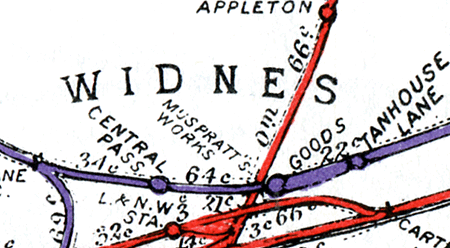 The goods facilities stretched from the eastern end of Ann Street East (in the west) to Tanhouse Lane (in the east). At the western end of the site the Widnes Branch came off a brick viaduct and it was at that point that the sidings began to fan out. A signal box called West End Goods was located on the north side of the line and controlled access to the yard. Little is known about the box other than that it had opened by 1890. It lasted only until 2 September 1912 when it was replaced with a ground frame. The goods facilities stretched from the eastern end of Ann Street East (in the west) to Tanhouse Lane (in the east). At the western end of the site the Widnes Branch came off a brick viaduct and it was at that point that the sidings began to fan out. A signal box called West End Goods was located on the north side of the line and controlled access to the yard. Little is known about the box other than that it had opened by 1890. It lasted only until 2 September 1912 when it was replaced with a ground frame.
Further east, on the south side of the main line, was the goods shed. It was a large brick building with a slate roof. There was a siding between it and the main line and a line that ran through it. To the south of the goods shed there were seven sidings.
On the north side of the main line there were five sidings which ran all the way up to Tanhouse Lane. At the eastern end of the yard, on the north side of the main line, was a two-road brick locomotive shed. By the 1890s the shed had its own turntable. The shed had an allocation of MSLR and MR engines.
A level crossing carried the Widnes branch over Tanhouse Lane and a signal box located on the north side of the main line controlled it. The box was a Stevens & Sons all-timber structure raised up on an extended base to give the signalman a better view of the line. The box had a 22-lever frame and a miniature lever for the gate lock.
Connections from the yard led directly into the Pilkingtons chemical works on the south side of the line and into the Cornubia works on the north side. There was also a connection to the Sullivan’s works to the east of Tanhouse Lane.
On 1 September 1890 a passenger station opened on the east side of Tanhouse Lane.
On 1 August 1897 the MSLR changed its name to the GCR. The GCR was merged into the London & North Eastern Railway (LNER) and the MR into the London Midland & Scottish Railway (LMS) at the Grouping of 1 January 1923. At Nationalisation on 1 January 1948 Tanhouse goods became part of British Railways’ London Midland Region (BR [LMR]).
The goods facilities at Tanhouse remained busy well into the 1950s. At Nationalisation the locomotive shed had become a sub-shed of Widnes locomotive depot and in 1955 it closed completely. After that date locomotives required for shunting duties and local work were provided by Widnes.
In 1955 a new connection was put into the USAC plant which was located to the north of the main line on the east side of Tanhouse Lane. The new line ran through the site of the former locomotive shed and crossed Tanhouse Lane by means of a level crossing located to the north of the main line crossing. Trains of anhydrite from Long Meg (on the Settle & Carlisle route) began to run to the plant. They came in via the Widnes Branch from the Hough Green direction. Other trains that ran to and from Tanhouse Lane at that time included chemical tanks and general merchandise. A cement works was built adjacent to the USAC plant that became Blue Circle Cement. Raw materials were brought to the plant from Hope in Derbyshire.
In 1961 a single-track chord was opened from Tanhouse Lane yard to the former LNWR Widnes and St Helens line. It was the first proper connection between the two systems (there had been connections via factories and private dock lines prior to then) and it allowed locomotives to travel easily between the yard and Widnes shed. In this period the most common engines engaged on shunting duties were ex-LMS 0-6-0T 3F (Jinties) number 47616 being a regular visitor.
During the early 1960s traffic levels at Tanhouse Lane began to decline. Passenger services were withdrawn from the Widnes Branch on 5 October 1964 and the line closed as a through route on 6 December 1964. Tanhouse Lane signal box was closed on the same day and replaced with a ground frame.
Tanhouse Lane closed to public goods services in the mid-1960s but the goods shed was taken over by British Road Services who continued to operate from it.
The main line through Tanhouse Lane was lifted in 1965 as were the sidings on the south side. The north side sidings and the line into USAC remained in situ but all traffic travelled via the 1961 chord.
The Long Meg anhydrite trains finished in 1973 leaving only cement traffic to the Blue Circle works. The cement trains worked to Tanhouse Lane as local trips from Widnes Hutchinson Street (having travelled to that location from Hope in Derbyshire) using BR class 08 locomotives.
By the mid-1970s Tanhouse Lane yard was a shadow of its former self with large areas of the site lying derelict. The goods shed was abandoned by 1978 and was demolished by 1980.
In 1981 BR[LMR] announced that it wished to close the Widnes and St Helens line as a through route and completely to the south of Clock Face. As regular cement trains were still running to the Blue Circle part of the St Helens line at Widnes it would have had to remain open. The solution was to create a new link to the Garston and Warrington line which passed very close to the western end of the Tanhouse Lane site. Work commenced on the new link and three new sidings in early 1982. The new sidings ran at an angle that occupied part of the main line trackbed and part of the site of the sidings that had been located south of the goods shed. The new connection opened on 18 April 1982 and the 1961 chord, along with the Widnes and St Helens line between Widnes No.1 and Widnes No.7 signal boxes closed, the line having closed as a through route on 1 November 1981. The original sidings that had been located to the north of the main line were lifted shortly after the 1961 spur closed.
Cement traffic continued to run to Tanhouse Lane until 2000. The sidings then lay disused until June 2008 when they were lifted. By 2014 the site had been partly developed with a public park (Moss Bank Park) and a fitness centre.
See Also
Widnes Central & Tanhouse Lane |

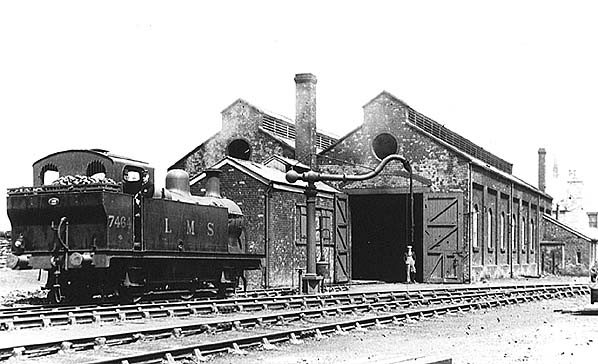
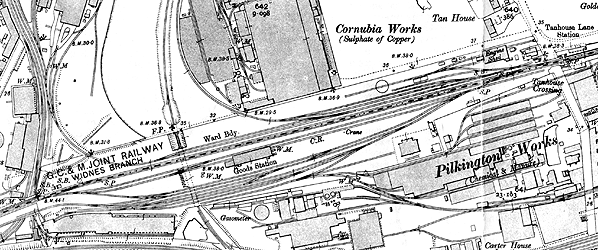
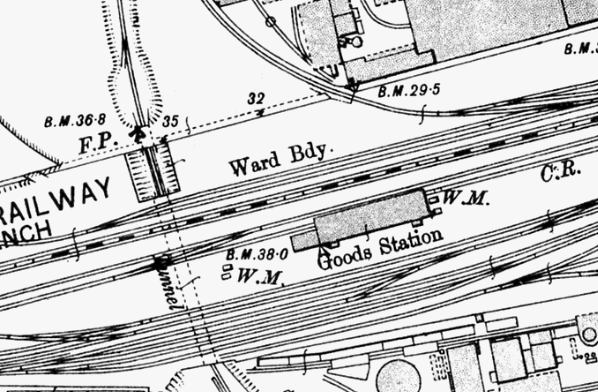 Tanhouse
Lane station shown on a 1905 1:200 scale map. Tanhouse Lane is to the west of the station and the level crossing is labelled. The small settlement of Moss Bank is seen to the north-east. South of the station is the large Sullivan's chemical works and to the west the engine shed.
Tanhouse
Lane station shown on a 1905 1:200 scale map. Tanhouse Lane is to the west of the station and the level crossing is labelled. The small settlement of Moss Bank is seen to the north-east. South of the station is the large Sullivan's chemical works and to the west the engine shed.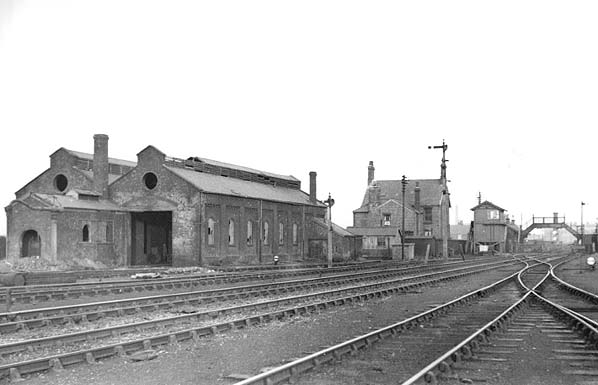
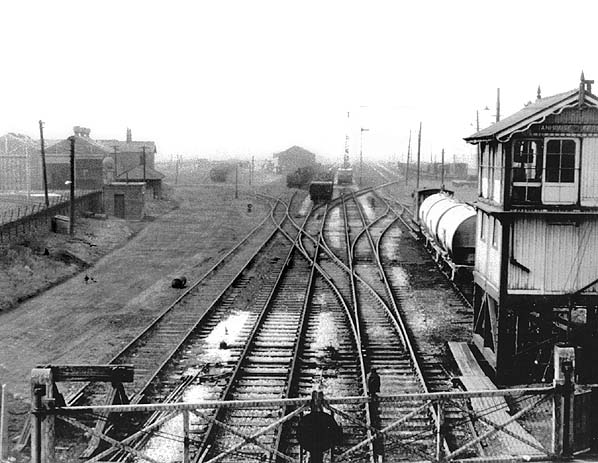
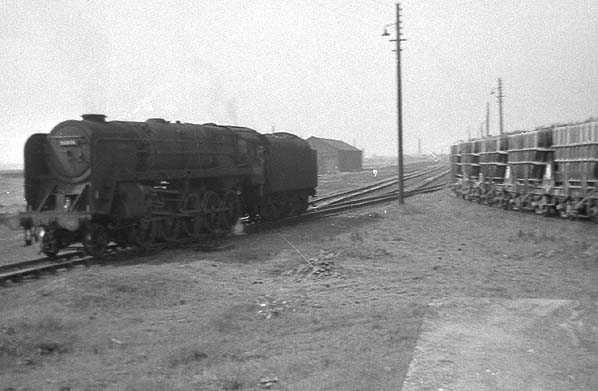
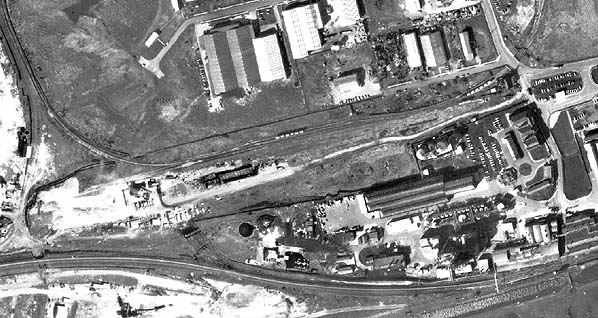 Tanhouse Lane goods seen from the air in 1975. The goods shed can be seen centre left with its roof removed. The 1961 spur that connected the yard to the LNWR Widnes and St Helens line is seen to the left. A row of six wagons are standing in the sidings while six more stand on the line into the Blue Circle cement works. Although still a functioning railway yard Tanhouse was a shadow of its former self.
Tanhouse Lane goods seen from the air in 1975. The goods shed can be seen centre left with its roof removed. The 1961 spur that connected the yard to the LNWR Widnes and St Helens line is seen to the left. A row of six wagons are standing in the sidings while six more stand on the line into the Blue Circle cement works. Although still a functioning railway yard Tanhouse was a shadow of its former self.

 Home Page
Home Page  The goods facilities stretched from the eastern end of Ann Street East (in the west) to Tanhouse Lane (in the east). At the western end of the site the Widnes Branch came off a brick viaduct and it was at that point that the sidings began to fan out. A signal box called West End Goods was located on the north side of the line and controlled access to the yard. Little is known about the box other than that it had opened by 1890. It lasted only until 2 September 1912 when it was replaced with a ground frame.
The goods facilities stretched from the eastern end of Ann Street East (in the west) to Tanhouse Lane (in the east). At the western end of the site the Widnes Branch came off a brick viaduct and it was at that point that the sidings began to fan out. A signal box called West End Goods was located on the north side of the line and controlled access to the yard. Little is known about the box other than that it had opened by 1890. It lasted only until 2 September 1912 when it was replaced with a ground frame.